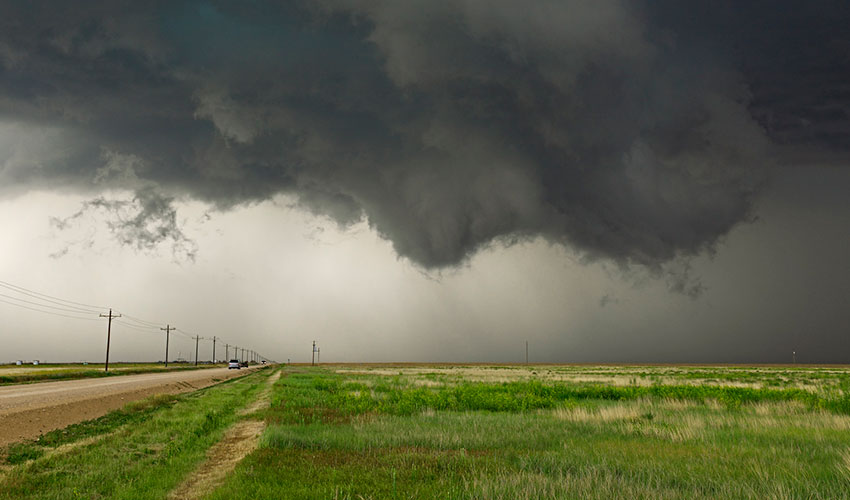Hail 101: Who’s at risk and preventing damage

Did you know the 1999 Sydney hailstorm was the most expensive natural disaster in Australian insurance history? It caused extensive damage along the east coast of New South Wales, with:
- An estimated 500,000 tonnes of hailstones falling in its path measuring up to 9cm in diameter
- homes damaged
- A total cost of damage estimated at $5.6 billion in today’s dollars
What is hail?
Hail forms during a thunderstorm when raindrops are carried upward into cold areas of the atmosphere, where they freeze into balls of ice. These balls of ice, or hailstones, can travel up to 200km/ph, range in size from a pea to a cricket ball, and can cause serious damage to metal and tiled roofs, skylights, windows, wall cladding, and cars.
Who is most at risk?
Although hail can occur any time of the year, much of the damage occurs between September and March, when warm and humid weather fuels severe thunderstorms.
While New South Wales and south-east Queensland are considered Australia's hail hot-spots, hailstorms can occur across all states of Australia. As recently as January 2020, Canberra suffered a severe hail storm resulting in over 37,000 insurance claims being lodged. The scale of the hail storm was the largest since Sydney in 1999.

How to prevent damage before a storm hits
- Clean debris from gutters and downpipes.
- Place outdoor furniture under cover.
- Ensure the roof is installed correctly, and is in good repair.
- Evaluate the age and condition of skylights and other roof fixtures, and undertake repairs where necessary. These items can become brittle as they age, increasing the risk of hail or water damage during a severe storm.
- Consider installing storm shutters on your windows and doors if you live in a hail-prone area as they can help protect glass from shattering.
- Consider a pool heat pump as opposed to roof solar heating, due to damage sustained to solar pool heating systems during hailstorms.
- Make sure you have the right insurance. If your home is damaged or a worker is injured while making repairs, you will want to make sure you have the right cover to protect your home and your family.
What to do during a hailstorm
- Stay informed: Monitor local weather and news updates if severe weather is forecast.
- Move inside: Seek shelter immediately until the storm subsides as hail can cause serious injury.
- Cover your car: Park it in a carport or garage.
- Protect your windows and external glazing: Close external shutters, drapes, blinds, and window shades and stay away from skylights and windows.
- Avoid injuries. To avoid storm-related electrical hazards, stay away from corded phones, electronics, and do not touch metal objects like stoves, metal pipes, and sinks.
What to do if you experience damage
- Cover up openings where possible: If it’s safe to do so, cover any broken areas of your roof or windows to keep water from entering and damaging your home’s interior. Place buckets under leaking skylights.
- Unblock roof gutters: Where it’s possible and only if it’s safe to do so, remove hail build up in gutters, particularly box gutters, to prevent a back flow of water into the home.
- : If it’s safe to do so, create a small opening in the ceiling where the water is entering using a thin, pointy object and place a bucket and towels below to catch water. This prevents plasterboard ceilings from sagging or collapsing due to the weight of the water and may enable repairs without having to remove the sheeting. The integrity of the plasterboard should not be affected once dried, and this may prevent lengthy and costly repairs.
- Contact your insurance company and broker to begin the claims process: If you’re a Chubb client, we’ll be able to refer you to a reputable contractor who can fix your home, quickly and without hassle, and will arrange alternative accommodation for you if you are unable to live in your home while it’s repaired.
Sources:
https://www.tandfonline.com/doi/full/10.1080/17477891.2019.1609406
https://www.munichre.com/topics-online/en/climate-change-and-natural-disasters/climate-change/Icy-cricket-balls-from-above.html
This content is brought to you by Chubb Insurance Australia Limited (“Chubb”) as a convenience to readers and is not intended to constitute advice (professional or otherwise) or recommendations upon which a reader may rely. Any references to insurance cover are general in nature only and may not suit your particular circumstances. Chubb does not take into account your personal objectives, financial situation or needs and any insurance cover referred to is subject to the terms, conditions and exclusions set out in the relevant policy wording. Please obtain and read carefully the relevant insurance policy before deciding to acquire any insurance product. A policy wording can be obtained at www.chubb.com/au, through your broker or by contacting any of the Chubb offices. Chubb makes no warranty or guarantee about the accuracy, completeness, or adequacy of the content. Readers relying on any content do so at their own risk. It is the responsibility of the reader to evaluate the quality and accuracy of the content. Reference in this content (if any) to any specific commercial product, process, or service, and links from this content to other third party websites, do not constitute or imply an endorsement or recommendation by Chubb and shall not be used for advertising or service/product endorsement purposes. ©2024 Chubb Insurance Australia Limited ABN: 23 001 642 020 AFSL: 239687. Chubb®, its logos, and Chubb.Insured.SM are protected trademarks of Chubb.

Have questions?
Contact a broker today.